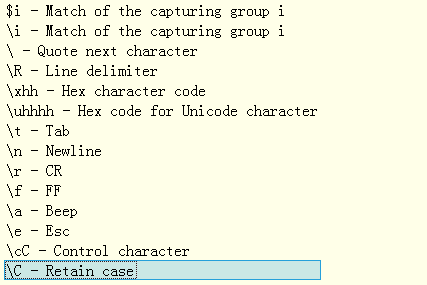Eclipse Regular expression grammar
http://www.eclipse.org/tptp/home/downloads/installguide/gla_42/ref/rregexp.html
Regular expression grammar
The Adapter Configuration Editor allows you to use regular expressions to describe how log files should be transformed into Common Base Event records. The following tables are a guideline to regular expression usage.
General rules
- | separates alternatives.
- Expressions within parentheses are matched as subpattern groups and saved for use by certain methods.
- By default, a quantified subpattern matches as many times as possible without causing the rest of the pattern not to match. To change the quantifiers to match the minimum number of times possible, without causing the rest of the pattern not to match, use a ? right after the quantifier.
- Perl5 extended regular expressions are fully supported.
Regular expression matching
| Expression | Matches |
|---|---|
| {n,m} | at least n but not more than m times |
| {n,} | at least n times |
| {n} | exactly n times |
| * | 0 or more times |
| + | 1 or more times |
| ? | 0 or 1 times |
| . | everything except \n in a regular expression within parentheses |
| ^ | a null token matching the beginning of a string or line (i.e., the position right after a newline or right before the beginning of a string) in a regular expression within parentheses |
| $ | a null token matching the end of a string or line (that is, the position right before a newline or right after the end of a string) in a regular expression within parentheses |
| \b | backspace inside a character class ([abcd]) |
| \b | null token matching a word boundary (\w on one side and \W on the other) |
| \B | null token matching a boundary that isn't a word boundary |
| \A | only at beginning of string |
| \Z | only at end of string (or before newline at the end) |
| \ | newline |
| \r | carriage return |
| \t | tab |
| \f | form feed |
| \d | digit [0-9] |
| \D | non-digit [^0-9] |
| \w | word character [0-9a-z_A-Z] |
| \W | non-word character [^0-9a-z_A-Z] |
| \s | a whitespace character [ \t\n\r\f] |
| \S | a non-whitespace character [^ \t\n\r\f] |
| \xnn | the hexadecimal representation of character nn |
| \cD | the corresponding control character |
| \nn or \nnn | the octal representation of character nn unless a backreference. |
| \1, \2, \3... | whatever the first, second, third, and so on, parenthesized group matched. This is called a backreference. If there is no corresponding group, the number is interpreted as an octal representation of a character. |
| \0 | the null character. Any other backslashed character matches itself . |
| *? | 0 or more times |
| +? | 1 or more times |
| ?? | 0 or 1 times |
| {n}? | exactly n times |
| {n,}? | at least n times |
| {n,m}? | at least n but not more than m times |
rouping and extracting matches
To group parts of an expression, use the metacharacters ( ). This allows the regular expression in the parentheses to be treated as a single unit. For example, the regular expression
severity:(1|2)
matches the pattern severity:1 or severity:2.






【推荐】国内首个AI IDE,深度理解中文开发场景,立即下载体验Trae
【推荐】编程新体验,更懂你的AI,立即体验豆包MarsCode编程助手
【推荐】抖音旗下AI助手豆包,你的智能百科全书,全免费不限次数
【推荐】轻量又高性能的 SSH 工具 IShell:AI 加持,快人一步
· Linux系列:如何用heaptrack跟踪.NET程序的非托管内存泄露
· 开发者必知的日志记录最佳实践
· SQL Server 2025 AI相关能力初探
· Linux系列:如何用 C#调用 C方法造成内存泄露
· AI与.NET技术实操系列(二):开始使用ML.NET
· 被坑几百块钱后,我竟然真的恢复了删除的微信聊天记录!
· 【自荐】一款简洁、开源的在线白板工具 Drawnix
· 没有Manus邀请码?试试免邀请码的MGX或者开源的OpenManus吧
· 园子的第一款AI主题卫衣上架——"HELLO! HOW CAN I ASSIST YOU TODAY
· 无需6万激活码!GitHub神秘组织3小时极速复刻Manus,手把手教你使用OpenManus搭建本